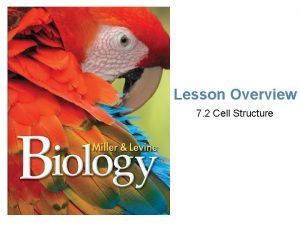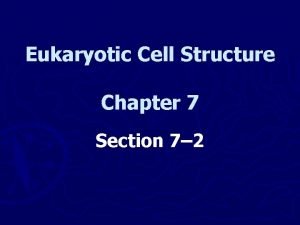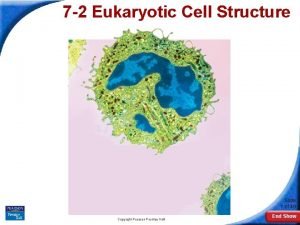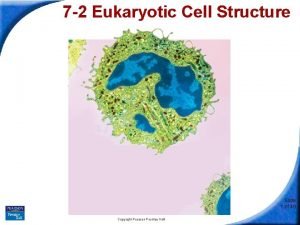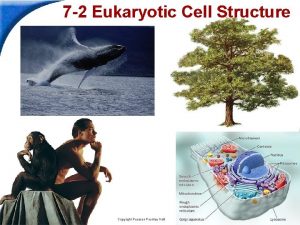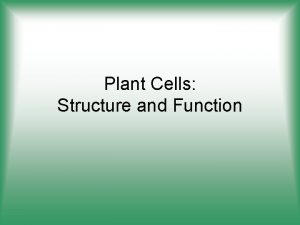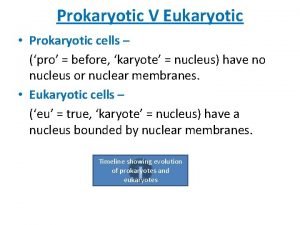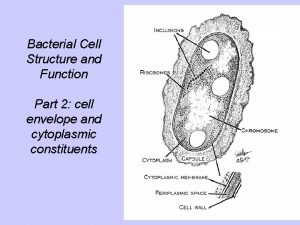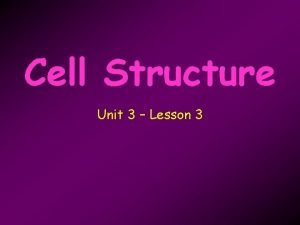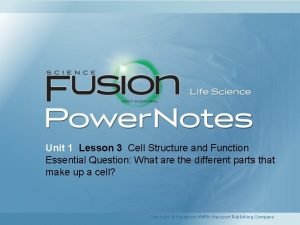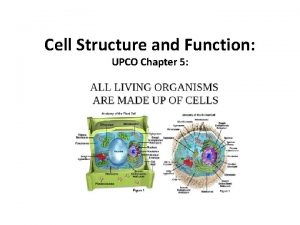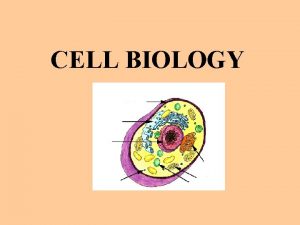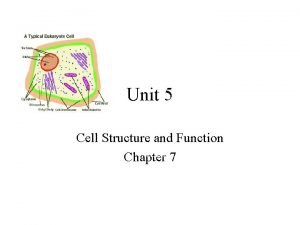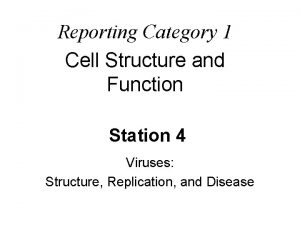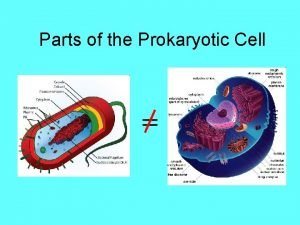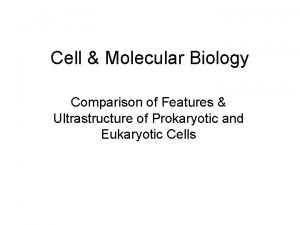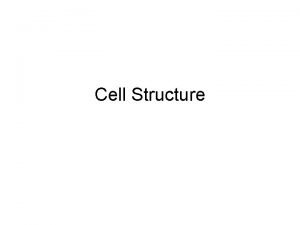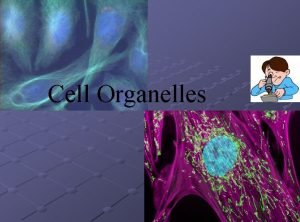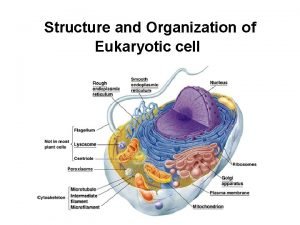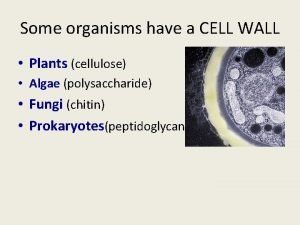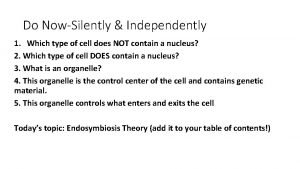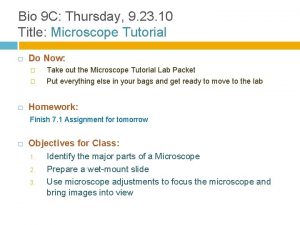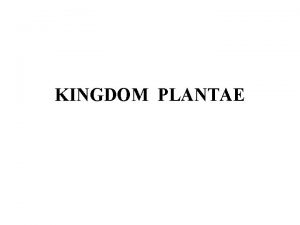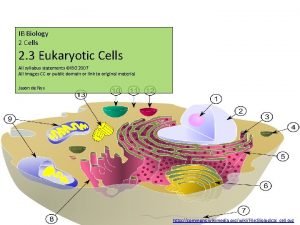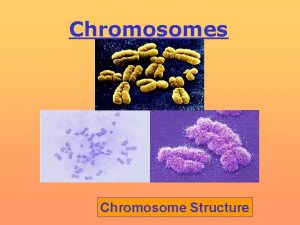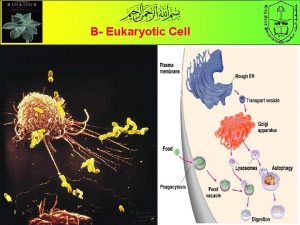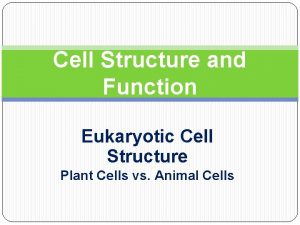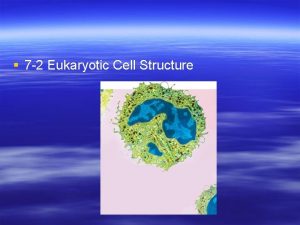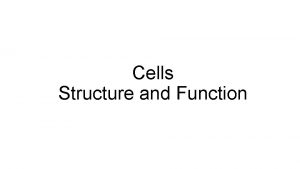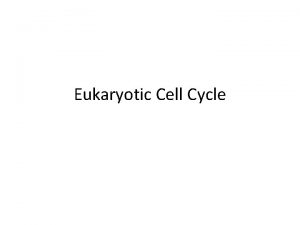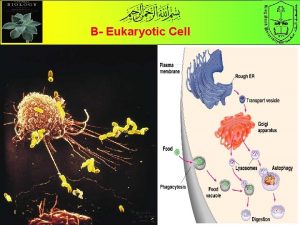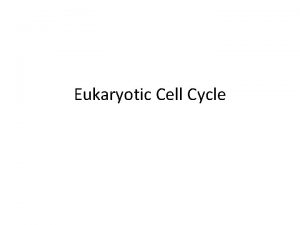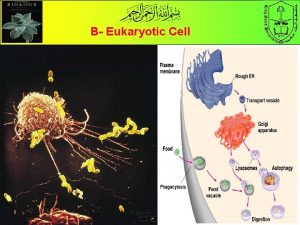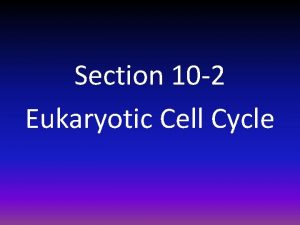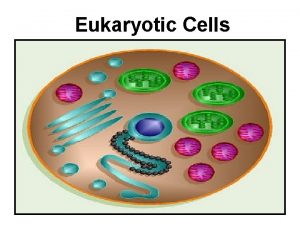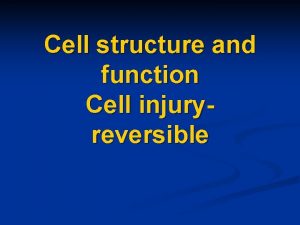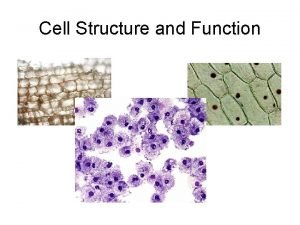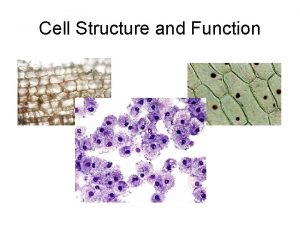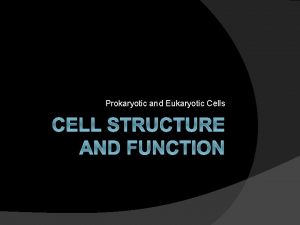The Cell Eukaryotic Structure and Function Eukaryotic true











































- Slides: 43

The Cell Eukaryotic Structure and Function

Eukaryotic (“true nucleus”) cells contain organelles

Organelles: • Are membrane bound • Are sub-cellular structures • Perform a specific function for the cell

A generalized eukaryotic cell diagram

Types of Eukaryotic Cells • • Animal Cells Plant Cells Fungi Cells Protist Cells W e’l n o s u l f oc an s t n pla d ls a m i an • Both types have many of the same internal parts but there also a few parts unique to either just plants or just animals. • Lets start with the parts common to both types…

Major Parts of the Eukaryotic Cell: • Cell Membrane: – Surrounds the cell – Controls movement into and out of cell – Made of PHOSPHOLIPIDS with imbedded proteins


Cytoplasm: • Remainder of the contents of the cell consisting of: – Cytosol: liquid environment – Cytoskeleton: network of protein fibers that supports the shape of the cell and anchors its organelles and serves as a “track” for them to move on.

Nucleus: – Controls the functions of the cell – Includes the following: • Nuclear Envelope: Controls movement into and out of the nucleus • Nuclear Pore: holes where movement takes place



Nucleus • Nucleolus – site of ribosome synthesis • Chromatin – DNA and associated proteins (some serve as enzymes, some are support). Condenses into chromosomes before cell division.

l Nucleus – can you name each part? ? ? ? ? ?

Ribosomes • Site of protein synthesis. • Are free or attached to ER. • Made of protein and RNA. •

Mitochondria • Transfer the energy in glucose to ATP (the cells usable form of energy) • Each has compartments formed by an inner folded membrane (cristae) surrounded by a smooth outer membrane


Endomembrane organelles • Organelles that work together to modify, process and ship molecules around and out of the cell • ER Golgi Vesicles


Endoplasmic Reticulum (ER): • Set of channels that aids in movement of molecules inside the cell.

Rough ER • Stacked, flattened sacs with many ribosomes attached. • Forms a link between the nuclear envelope and the ribosomes.

Smooth ER • No ribosomes • Area from which vesicles carrying proteins and lipids are budded.


Golgi apparatus • Stacks of membranous sacs that modify, sort and ship proteins (such as enzymes and hormones).

Golgi apparatus • Material received from the rough ER are processed and packaged in vesicles which will either stay in the cell or will be secreted to the outside of the cell.

Golgi apparatus • Cells that secrete hormones (i. e. pancreas) have extensive Golgi development

See animations 13. 2 and 13. 3 Vesicles • Transport material between organelles and to and from the cell membrane


Plant Cell

Specialized plant cell structures: Chloroplasts – Oval or disc shaped, bound by a double membrane – On the thylakoid membrane, pigments and enzymes trap sunlight energy to form ATP – Glucose is formed in the fluid substance surrounding the stacks (stroma)


Specialized plant cell structures: Cell wall • A stiff layer of cellulose outside the plasma membrane that provides support to the cell • Microscopic pores allow water and solute passage to and from the underlying plasma membrane

Specialized plant cell structures: Vacuole • Stores amino acids, sugars, ions, water and waste. • Can occupy up to 90% of the cells interior


Specialized plant cell structures: Plastids • Function in food production and storage


Animal Cell

Animal Cell Structures: Lysosomes • Carry powerful enzymes that digest worn out cell parts or foreign particles.



Animal Cell Structures: Centrioles: • Cylindrical organelles formed by hollow protein fibres called microtubules (part of the cytoskeleton) which aid in moving chromosomes during cell division.



 Prokaryotic reproduction
Prokaryotic reproduction Life
Life Prokaryotic vs eukaryotic cell
Prokaryotic vs eukaryotic cell Eukaryotic cell animal cell
Eukaryotic cell animal cell Eukaryotic vs prokaryotic cells
Eukaryotic vs prokaryotic cells Cell structure
Cell structure The distinct threadlike structures that contain the genetic
The distinct threadlike structures that contain the genetic Biology chapter 7 cell structure and function
Biology chapter 7 cell structure and function 7-2 eukaryotic cell structure
7-2 eukaryotic cell structure 7-2 eukaryotic cell structure
7-2 eukaryotic cell structure 7-2 eukaryotic cell structure
7-2 eukaryotic cell structure Eukaryotic plant
Eukaryotic plant Prokaryotic
Prokaryotic Function of cells
Function of cells What is part 2
What is part 2 Lesson 3 cell structure and function answer key
Lesson 3 cell structure and function answer key Organelles graphic organizer
Organelles graphic organizer Cytoplasm function
Cytoplasm function Lesson 3 cell structure and function answer key
Lesson 3 cell structure and function answer key Chapter 7 cell structure and function section review 7-2
Chapter 7 cell structure and function section review 7-2 Organelle graphic organizer
Organelle graphic organizer Chapter 5 cell structure and function
Chapter 5 cell structure and function Plastids in plant cell
Plastids in plant cell Unit 5 cell structure and function answer key
Unit 5 cell structure and function answer key Category 1 cell structure and function
Category 1 cell structure and function Category 1 cell structure and function
Category 1 cell structure and function Category 1 cell structure and function
Category 1 cell structure and function Chapter 2 jesus christ true god and true man
Chapter 2 jesus christ true god and true man Euglena prokaryotic or eukaryotic
Euglena prokaryotic or eukaryotic Typical eukaryotic cell
Typical eukaryotic cell Eukaryotic cell organisation
Eukaryotic cell organisation Difference between prokaryote and eukaryotes
Difference between prokaryote and eukaryotes Eukaryotic cells
Eukaryotic cells Protien pump
Protien pump Are cell walls prokaryotic or eukaryotic
Are cell walls prokaryotic or eukaryotic Are cell walls prokaryotic or eukaryotic
Are cell walls prokaryotic or eukaryotic Plant cell
Plant cell Cell organelle
Cell organelle Eukaryotic cell
Eukaryotic cell Ib biology eukaryotic cell diagram
Ib biology eukaryotic cell diagram Prokaryotic cell wall
Prokaryotic cell wall Amer rasheed
Amer rasheed How to read chromosome
How to read chromosome Eukaryotic chromosome structure
Eukaryotic chromosome structure





